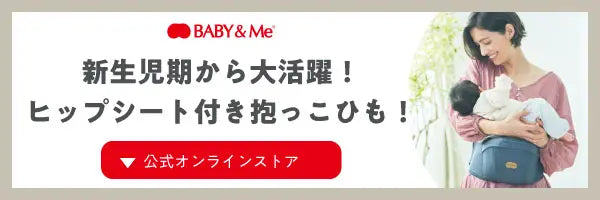Points to note when holding a newborn baby and recommended items
A newborn baby, small and unreliable. If you are not used to it, you may feel uneasy about holding your pet.
However, holding your baby has many benefits, such as the ability for your baby to feel the warmth and heartbeat of mom and dad and feel safe. Please remember the precautions and the correct way to hold your pet, and actively hold them.
What characteristics do newborn babies have?
 A newborn baby, as the name suggests, is a "newly born child." This refers to babies up to 28 days old, or about 1 month old.
A newborn baby, as the name suggests, is a "newly born child." This refers to babies up to 28 days old, or about 1 month old.
I can see the brightness and darkness of the light and vague outlines, but I can't see clearly yet. Their hearing and sense of smell are relatively well developed, so they may be startled awake by a loud noise while sleeping, or stop crying if you gently speak to them. They can smell breast milk, so they react when mom comes near them.
Since their bones and muscles are underdeveloped and their bodies are squishy, you must handle them carefully when picking them up to avoid putting them in an unnatural position and putting too much stress on them.
What types of hugging methods are there?
 Holding your baby upright so that the baby's body is perpendicular to the ground is called ``vertical holding.'' On the other hand, ``side-hugging'' is when you lay down your body so that it is close to parallel to the ground.
Holding your baby upright so that the baby's body is perpendicular to the ground is called ``vertical holding.'' On the other hand, ``side-hugging'' is when you lay down your body so that it is close to parallel to the ground.
When a baby is around 4 months old, they will be able to sit up and support their head on their own, but before that, the head will be wobbly due to lack of neck strength. For this reason, during the newborn period, it is essential to hold your baby sideways, which provides more stability.
Of course, it is OK to hold him vertically as long as you support his neck properly.
There are opportunities to hold your baby vertically even during the newborn period, for example when burping after breastfeeding. Perhaps because the baby is in close contact with mom's body and can hear the heartbeat, babies tend to sleep more easily when held vertically, so if you have trouble putting them to sleep, it might be a good idea to try that.
What is the procedure for holding?
 If you want to hold your baby on your side, approach your baby from right next to your sleeping baby.
If you want to hold your baby on your side, approach your baby from right next to your sleeping baby.
Lift your baby's head slightly with your hand on the side of your baby's foot, then place your other arm under their head. Place the inside of your elbow under your baby's neck and gently place your arm along the baby's body.
Place your remaining hand behind the baby's knees and scoop it up.
The key is to lean forward and bring your bodies close to each other, and when you pick him up, make sure your bodies are firmly in contact with each other.
When holding your baby vertically, stand by so that you are facing the baby's feet.
Place one hand behind the baby's head to support the baby's neck and head, then place the other hand under the baby's hips and pull the baby towards your chest to raise your baby up.
Let him lean against your chest, keeping the hands on his head and neck, and slide the hand on his hips to support his hips with your entire arm.
It is important to have a good fit, but be careful not to block your baby's mouth or nose.
What should you be careful about when holding a newborn?
 When carrying a baby who has yet to sit up, the most important thing to be careful about is supporting the baby's neck firmly. Your baby's head is heavy, so it's essential to support your baby by placing your hands on the back of his head and neck to keep him from wobbling.
When carrying a baby who has yet to sit up, the most important thing to be careful about is supporting the baby's neck firmly. Your baby's head is heavy, so it's essential to support your baby by placing your hands on the back of his head and neck to keep him from wobbling.
Also, it is natural for a baby's arms to be slightly bent so that they form a W-shape and their legs to form an M-shape. Make sure that it is not stretched too much or bent too much.

It is also important that your back is slightly rounded and curved into a gentle C shape. Be careful not to bend it too much or twist it to the left or right, making it asymmetrical.
Carrying your baby in a stable position is important not only for the baby's sense of security and safety, but also to reduce the burden on mom and dad. Make sure to keep your elbows away from your body so that your bodies are in close contact with each other, and keep your upper body relaxed and in a relaxed position.
Is it true that a hip seat can be used from the newborn stage?
 This hip seat has a waist pouch-shaped base and is used for holding children. You may think that you should use it after your baby grows relatively large and heavy, but it is actually useful from the newborn stage.
This hip seat has a waist pouch-shaped base and is used for holding children. You may think that you should use it after your baby grows relatively large and heavy, but it is actually useful from the newborn stage.
Even a newborn baby weighs 3 to 4 kg, so it can be a burden to hold your baby while breastfeeding or putting him to bed every day. You can reduce the strain caused by the baby's weight by placing your baby's butt on the hip seat and holding the baby sideways.
BABY&Me's BELK-S first set includes a hip seat, a carrier part that wraps around the baby's body, and a waist belt (first part) that gently wraps around the baby's waist. Since the hip seat can be used alone, it is also convenient for supporting newborns when they are held next to each other.

The carrier part has a structure that firmly supports the neck area, so if you combine it with the first part, it can be used as a baby carrier from before the neck is seated. After sitting down, you can switch the first part to the hip seat and use it as a hip seat carrier.
It can be used for a long time from newborn to around 4 years old, so there is no need to replace or buy more. It is recommended not only for its functionality but also for its cost performance.































